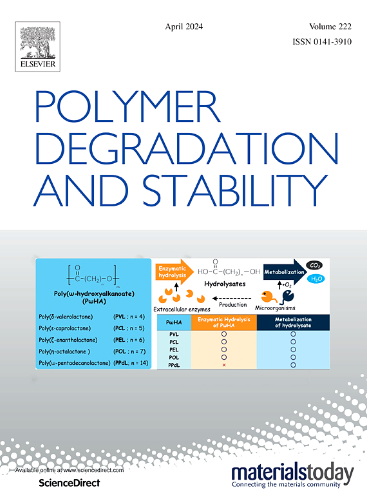Facile construction of highly efficient MXene-based P-N biomass intumescent flame retardant system to improve the fire safety of EP coating using mechanochemistry
IF 6.3
2区 化学
Q1 POLYMER SCIENCE
引用次数: 0
Abstract
The development of MXene-based epoxy (EP) coatings with superior fireproofing properties has garnered significant attention for aerospace applications. In this study, MXene@PAA was obtained by simultaneously exfoliating multilayer MXene and reacting it with phosphorus-nitrogen (P-N)-containing biomass-derived phytate ammonium (PAA) via a mechanochemical ball-milling approach. This nanohybrid was then incorporated into EP matrix to construct an intumescent flame-retardant system (IFRs) exhibiting exceptional fire safety, thermal shielding, and hydrophobic de-icing performance. Notably, MXene@PAA significantly enhanced the flame retardancy, smoke suppression, and toxicity reduction of EP coatings even at low loading levels. Remarkably, with only 4 wt % MXene@PAA, EP coating achieved a UL-94 V0 rating and a limiting oxygen index (LOI) of 32.8 %. Furthermore, compared to pure EP, the EP-4MXene@PAA sample demonstrated a 77.85 % reduction in peak heat release rate (pHRR), a 38.81 % decrease in total heat release (THR), and 77.71 % and 77.52 % reductions in peak CO (pCOP) and CO2 production (pCO2P), respectively. Meanwhile, the char residue mass increased by 63.96 %, while the expansion height of the char residue layer rose from 0.5 cm to 3.6 cm. In addition, EP-4MXene@PAA not only has significantly better thermal shielding performance, but also has a significantly faster rate of surface ice melting and sliding. This work offers an effective method for creating multifunctional MXene-based nanohybrid and related polymer nanocomposites, showing great potential for next-generation fire-safe aerospace materials.
利用机械化学方法快速构建高效mxeni基P-N生物质膨胀阻燃体系,提高EP涂层的防火安全性
具有优异防火性能的mxene基环氧树脂(EP)涂料的开发已经引起了航空航天应用的极大关注。本研究将多层MXene同时剥离,并通过机械化学球磨法与含磷氮(P-N)的生物质衍生植酸铵(PAA)反应,得到MXene@PAA。然后将这种纳米混合材料掺入EP基质中,构建膨胀型阻燃系统(ifr),该系统具有优异的防火安全性、热屏蔽性和疏水除冰性能。值得注意的是,MXene@PAA即使在低负荷水平下也显著增强了EP涂层的阻燃性、抑烟性和毒性降低。值得注意的是,仅用4 wt % MXene@PAA, EP涂层就达到了UL-94 V0等级和32.8%的极限氧指数(LOI)。此外,与纯EP相比,EP-4MXene@PAA样品的峰值放热率(pHRR)降低了77.85%,总放热率(THR)降低了38.81%,峰值CO (pCOP)和CO2产量(pCO2P)分别降低了77.71%和77.52%。同时,炭渣质量增加了63.96%,炭渣层膨胀高度由0.5 cm增加到3.6 cm。此外,EP-4MXene@PAA不仅具有明显更好的热屏蔽性能,而且具有明显更快的表面冰融化和滑动速度。这项工作为创建多功能mxeni基纳米杂化和相关聚合物纳米复合材料提供了有效的方法,在下一代防火航空航天材料中显示出巨大的潜力。
本文章由计算机程序翻译,如有差异,请以英文原文为准。
求助全文
约1分钟内获得全文
求助全文
来源期刊

Polymer Degradation and Stability
化学-高分子科学
CiteScore
10.10
自引率
10.20%
发文量
325
审稿时长
23 days
期刊介绍:
Polymer Degradation and Stability deals with the degradation reactions and their control which are a major preoccupation of practitioners of the many and diverse aspects of modern polymer technology.
Deteriorative reactions occur during processing, when polymers are subjected to heat, oxygen and mechanical stress, and during the useful life of the materials when oxygen and sunlight are the most important degradative agencies. In more specialised applications, degradation may be induced by high energy radiation, ozone, atmospheric pollutants, mechanical stress, biological action, hydrolysis and many other influences. The mechanisms of these reactions and stabilisation processes must be understood if the technology and application of polymers are to continue to advance. The reporting of investigations of this kind is therefore a major function of this journal.
However there are also new developments in polymer technology in which degradation processes find positive applications. For example, photodegradable plastics are now available, the recycling of polymeric products will become increasingly important, degradation and combustion studies are involved in the definition of the fire hazards which are associated with polymeric materials and the microelectronics industry is vitally dependent upon polymer degradation in the manufacture of its circuitry. Polymer properties may also be improved by processes like curing and grafting, the chemistry of which can be closely related to that which causes physical deterioration in other circumstances.
 求助内容:
求助内容: 应助结果提醒方式:
应助结果提醒方式:


